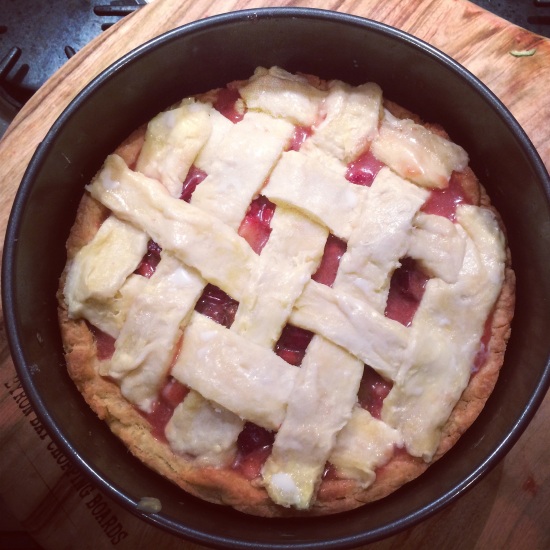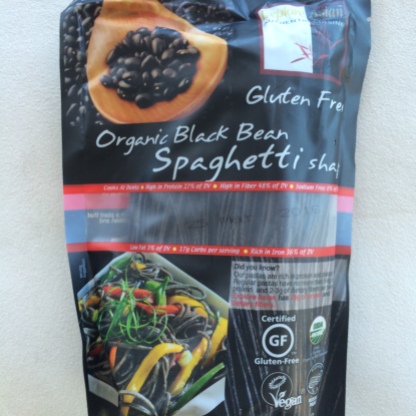
Thanksgiving snuck up on us last year — we thought we’d play it cool and celebrate by going out for a meal with some Aussie friends but it turned out we needed more of a fix.
This time we’re on the ball! We’ve already had a Friendsgiving and a Worksgiving (is that a thing?) and the real Thanksgiving isn’t even for another 5 days.
I decided this year to branch out from my go-to recipes and try something different. So, for Friendsgiving, I made roast butternut squash soup. It was so good and so easy! (Recipe on the way). I also made a strawberry rhubarb pie.

Strawberry rhubarb isn’t a typical Thanksgiving pie. However, it IS summer down here. I’m a sucker for strawberries and rhubarb, especially together and more so in the summer when they’re at their peak. Besides, filling a pie with fresh fruit rather than sugar or custard makes it feel infinitely healthier.. am I right?? Before we get to the recipe, let’s talk about the cardinal rule of pie-making:
Homemade crust is the best crust
The key to a good pie is the crust. It’s the first thing you bite into and the last thing you taste. It introduces the pie and sets the tone for what’s to come. You might not swoon over a pie made with perfect crust and a poor filling, but a delicious filling will never make up for a mediocre pie crust.
A good crust has texture and flavor; it’s something you’d eat even without the filling. A great pie crust complements the yummy goodness it’s transporting into your mouth. Tangy key lime? Go with a punchy graham cracker crust. Creamy, custard? Try a textured crust made of crushed pecans. Fruit pie? Keep it simple and let the fruit shine.
Making your own pie crust might sound time-consuming and tedious but it’s actually pretty easy. More importantly, once you’ve had a good homemade crust, you’ll never go back to those bland, greasy, unsatisfying substitutes. Why would you want to waste your precious calories, not to mention your delicious pie filling, on something mass-produced and supermarket-bought? Home made all the way!
Easy, 5-step pie crust
This crust is all butter and although it may seem intimidating, it’s really only five steps. Don’t be put off by the big paragraphs for each step. I’m only trying to make this easy for you!
Prep time: 45 mins | Fridge time: 1+ hours or overnight | Cook time: 20 mins | Yields: 2 base crusts or 1 base and 1 top
Ingredients
- 3 cups of flour
- 250gms unsalted butter
- 10 tablespoons ice water
- 1/2 teaspoon fine salt
- Pie weights (or lima beans or coins) for blind baking
- A rolling pin
- A 9″ pie or springform dish (if you like deep dish pie)
Method
1. First things first: you want your butter to be cold. Not melting, not room temperature, cold. The trick to getting your crust all flaky and textured is to leave chunks of butter intact in the dough. If you let the butter melt or if you overwork the dough, your pie crust will be tough and chewy. So, if your kitchen counter is next to a toasty warm oven, a burning stovetop or a dishwasher, take your butter some place else. Once you’re alone with your butter in a nice cool place, chop it into cubes and stick it back in the fridge.
2. Next, measure 3 cups of flour and 1/2 tsp of fine salt into a large bowl and stir to mix and aerate. Take your chopped butter out of the fridge and begin working into the dry mix. You can use a pastry blender to speed things up here or you can go old school and use your fingers. If you’re using your fingers, I’ll tell you what my 4th grade teacher taught me: wash and dry your hands (duh!) and use only the tips of your fingers! Get your palm in there and you’re sure to create a buttery mess and ruin your dough. Once you’re done, your pre-dough should look like giant crumbs the size of lima beans.
3. Get your ice water out of the freezer and add a few tablespoons at a time, mixing until the dough just comes together. Be very careful not to add too much water and not overwork the dough. Your final dough should be moist but flaky, not sticky. Divide the dough in half, flatten each piece into a disc, cover with plastic wrap and put it in the fridge. You can leave the dough discs overnight or you can ready them for baking within an hour.

4. Take your chilled disc out of the fridge and place it on a clean, cool and well-floured surface. Dust the rolling pin with flour and start rolling. The dough is going to want to stick onto the countertop but the trick here is to roll and move. Flip the dough over, move it around, do whatever it takes to keep it from sticking. You’ll want to shape it into a 12″ circle so that it’ll sit in your 9″ pie dish with about 1″ of overhang. Once you’re there, transfer it into your greased and floured pie dish (I like to use a spring form because I’m a fan of deep dish pies) and crimp the edges, using your index finger and thumb. A quick video on fluting here.
5. Finally, you’re going to blind bake your pie crust. The reason you do this is because cooking a fruit filling without a baked crust can lead to soggy crust syndrome. Nuh uh, you don’t want that. So, line the dough with baking paper or foil, and weigh down with pie weights, dry beans or clean coins. I like to use coins because they’re heavy and also good conductors of heat. Place your pie dish in a middle rack and bake at 450F / 220C for 15-20 minutes until the crust starts to look golden brown. Remove and set aside to cool.
Very strawberry rhubarb pie: the filling
Now that your crust is done, the filling is easy peasy. But first, rhubarb: rhubarb is one of my favourite things. It’s gorgeous, tongue numblingly sour (at least to me) and it reminds me so much of England. Most importantly, rhubarb and strawberries are a match made in heaven. Here’s what you’ll need:
Ingredients
- 2 cups of unpeeled, diced rhubarb stalks
- 2 cups of diced strawberries
- 1-2 cups sugar depending of tartness of fruit
- 1 tsp orange or lemon rind
- 1 tblsp butter
- 3 tblsp cornstarch or arrowroot or 6 tblsp flour to thicken
- Egg wash or milk
- Prebaked pie crust (see above)
Combine the filling ingredients in a big bowl and let it sit for 15 minutes. Spoon the pie filling into your pre-baked pie crust. Ta da!
(Psst: the reason the thickener is in there is to prevent your filling from getting runny and soggify your pie. Don’t want that!)

The last step in your pie baking adventure is the top crust. I opted for a lattice-style design but you can go with something simpler. The NY Times has recently done an amazing pie piece for Thanksgiving and has lots of top crust ideas here.

Brush the top of your pie crust with milk or an egg wash to encourage browning and bake in the oven at 400F for 30 minutes or until the top is golden brown and the fruit starts to bubble. Enjoy!





















 Wash the uncut okra and lay flat on a paper towel. Pat the okra dry. Note** do not slice the okra while it’s wet. More importantly, do not wash the okra once it’s been cut — this is crucial if you are to get crisp texture rather than a soggy one.
Wash the uncut okra and lay flat on a paper towel. Pat the okra dry. Note** do not slice the okra while it’s wet. More importantly, do not wash the okra once it’s been cut — this is crucial if you are to get crisp texture rather than a soggy one. 



















